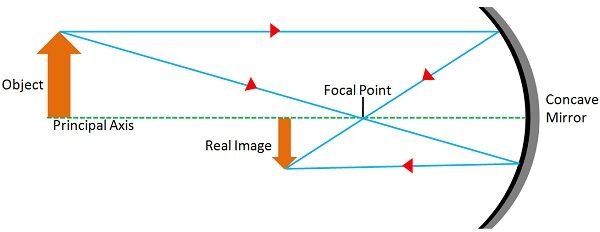 When the incident rays arise from a given object, then it is known as a real object. Further, the light rays emanating from the real object after reflection from the mirror, meet at a certain point, then the optically formed reproduction of an object is known as an image. The two types of images which are formed are real image and virtual image. The real image implies the representation of an actual object, produced when the light rays arising from a single source converge at a particular (real) point.
When the incident rays arise from a given object, then it is known as a real object. Further, the light rays emanating from the real object after reflection from the mirror, meet at a certain point, then the optically formed reproduction of an object is known as an image. The two types of images which are formed are real image and virtual image. The real image implies the representation of an actual object, produced when the light rays arising from a single source converge at a particular (real) point.
On the contrary, the virtual image can be understood as the image produced due to the apparent divergence of rays of light from a definite point.
The article excerpt presented to you, simplifies the difference between real image and virtual image.
Content: Real Image Vs Virtual Image
Comparison Chart
| Basis for Comparison | Real Image | Virtual Image |
|---|---|---|
| Meaning | Real image is the image which is formed when the light rays meet at a particular point after reflection from the mirror. | Virtual image refers to the image which forms when the light rays appear to meet at definite point, after reflection from the mirror. |
| Rays | Rays actually converge | Rays perceived to converge |
| Image formed | Inverted | Upright |
| Lens used | Converging Lens | Diverging Lens |
| Mirror | Concave Mirror | Convex, Concave and Plane Mirror |
Definition of Real Image
A real image can be described as a reproduction of a real object formed at the point where the light rays originating from a particular object converge. It can be obtained on the screen when the screen is set in the plane of the image. The image formed on the cinema screen, of the theatre with the use of the projector is the practical example of a Real image.
 Concave mirror or a converging lens are used to produce a real inverted image, wherein the object should be located in front of the lens or mirror, at a place farther than the focus. Depending upon the position of the object, the size of the image may vary, i.e. it can be diminished or enlarged.
Concave mirror or a converging lens are used to produce a real inverted image, wherein the object should be located in front of the lens or mirror, at a place farther than the focus. Depending upon the position of the object, the size of the image may vary, i.e. it can be diminished or enlarged.
Definition of Virtual Image
The virtual image is understood as an optical image that is produced from the apparent divergence of the rays of light emanating from a point on an object. So, an upright image is formed at the point where the rays only seem to diverge, but do not converge in reality.
 In other words, the image formed on reaching the light rays to our eyes, that appear to arise from an actual object, however, there is no such object present at the apparent light source. The best example of the virtual image is the image produced in a plane mirror.
In other words, the image formed on reaching the light rays to our eyes, that appear to arise from an actual object, however, there is no such object present at the apparent light source. The best example of the virtual image is the image produced in a plane mirror.
A diverging lens or convex mirror is used to produce a virtual image which is diminished in size when compared to the actual size of the object. However, it can also be formed by the converging lens and concave mirror, when the object is between focus and pole.
Key Differences Between Real Image and Virtual Image
The difference between real image and virtual image can be drawn clearly on the following premises:
- A real image can be defined as the image produced by the reflection or refraction when the light rays arising from the object converge at a specific point. On the other hand, a virtual image refers to an image produced when the light rays originating from an object only appear to strike at a certain point.
- The real image is produced by the actual intersection of the rays of light. Hence they can be captured on the screen. Conversely, there is an imaginary intersection of the rays of light in the case of virtual mage, so it cannot be cast on the screen.
- In general, real images are inverted, whereas virtual images are erect.
- The converging lens is used to form a real image. As against, a virtual image is produced with the help of a diverging lens.
- The concave mirror is used in producing a real image. However, virtual images are produced by a plane mirror, convex mirror and sometimes by concave mirror also.
Conclusion
The basic difference between real image and the virtual image is that the former can be captured on the screen in the real world and appears on the same side, like that of the object, whereas the latter cannot be reproduced on the screen in the real world and exist on the opposite of the mirror.






harsh says
best website to get useful information…
Ahnaf says
Good helper!
Manthan says
It is good knowledge . Thanks .